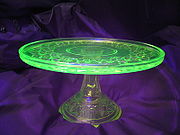
Adolf Patera
Encyclopedia

Uranium
Uranium is a silvery-white metallic chemical element in the actinide series of the periodic table, with atomic number 92. It is assigned the chemical symbol U. A uranium atom has 92 protons and 92 electrons, of which 6 are valence electrons...
in colour production in glass, and associated with silver extraction from the mines at Joachimsthal, then part of the Austro-Hungarian Empire, now known as Jáchymov. Pateraite, supposedly a cobalt
Cobalt
Cobalt is a chemical element with symbol Co and atomic number 27. It is found naturally only in chemically combined form. The free element, produced by reductive smelting, is a hard, lustrous, silver-gray metal....
molybdate
Molybdate
In chemistry a molybdate is a compound containing an oxoanion with molybdenum in its highest oxidation state of 6. Molybdenum can form a very large range of such oxoanions which can be discrete structures or polymeric extended structures, although the latter are only found in the solid state.The...
, is named after him.
Patera studied at the Academy in Banská Štiavnica
Banská Štiavnica
Banská Štiavnica is a town in central Slovakia, in the middle of an immense caldera created by the collapse of an ancient volcano. For its size, the caldera is known as Štiavnica Mountains. Banská Štiavnica has a population of more than 10,000. It is a completely preserved medieval town...
between 1839 and 1843.
Toward the mid 19th century the rich silver ore of Joachimsthal had been almost exhausted and instead miners encountered a heavy black mineral which they named "Pechblende". Martin Heinrich Klaproth
Martin Heinrich Klaproth
Martin Heinrich Klaproth was a German chemist.Klaproth was born in Wernigerode. During a large portion of his life he followed the profession of an apothecary...
, a chemist, found that it could be used in dye industry. This happened shortly after the discovery of Uranus
Uranus
Uranus is the seventh planet from the Sun. It has the third-largest planetary radius and fourth-largest planetary mass in the Solar System. It is named after the ancient Greek deity of the sky Uranus , the father of Cronus and grandfather of Zeus...
and Klaproth dubbed the black uranium oxide powder "uranium
Uranium
Uranium is a silvery-white metallic chemical element in the actinide series of the periodic table, with atomic number 92. It is assigned the chemical symbol U. A uranium atom has 92 protons and 92 electrons, of which 6 are valence electrons...
", mistakenly believing it to be an element. Adolf Patera was asked to examine the commercial possibilities of the new substance, and he presented a paper on the use of uranium to the Imperial Academy of Science in 1847, also describing a method of vanadium
Vanadium
Vanadium is a chemical element with the symbol V and atomic number 23. It is a hard, silvery gray, ductile and malleable transition metal. The formation of an oxide layer stabilizes the metal against oxidation. The element is found only in chemically combined form in nature...
extraction from the uranium ores.
This led to the construction of a new factory which started production in 1853 of uranium pigments (sodium, potassium and ammonium diuranates, uranium oxides) for the production of uranium glass
Uranium glass
Uranium glass is glass which has had uranium, usually in oxide diuranate form, added to a glass mix before melting. The proportion usually varies from trace levels to about 2% by weight uranium, although some 19th-century pieces were made with up to 25% uranium.Uranium glass was once made into...
from high-grade pitchblende in a process developed by Patera. The process resulted in waste with a high radium content and was used by Pierre
Pierre Curie
Pierre Curie was a French physicist, a pioneer in crystallography, magnetism, piezoelectricity and radioactivity, and Nobel laureate. He was the son of Dr. Eugène Curie and Sophie-Claire Depouilly Curie ...
and Marie Curie
Marie Curie
Marie Skłodowska-Curie was a physicist and chemist famous for her pioneering research on radioactivity. She was the first person honored with two Nobel Prizes—in physics and chemistry...
in their separation of radium. The lustrous fire-resistant dyes coming in so many shades of yellow, black, orange and green became extremely popular and they were used as a matter of course for Czech glass
Bohemian glass
Bohemian glass, or Bohemia crystal, is a decorative glass produced in regions of Bohemia and Silesia, now in the current state of the Czech Republic, since the 13th century. Oldest archaeology excavations of glass-making sites date to around 1250 and are located in the Lusatian Mountains of...
and porcelain decoration, with burgeoning exports to Great Britain and France. Uranium glass is considered to be harmless and only marginally more active than background radiation
Background radiation
Background radiation is the ionizing radiation constantly present in the natural environment of the Earth, which is emitted by natural and artificial sources.-Overview:Both Natural and human-made background radiation varies by location....
.

